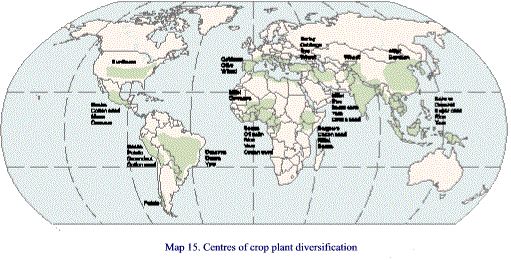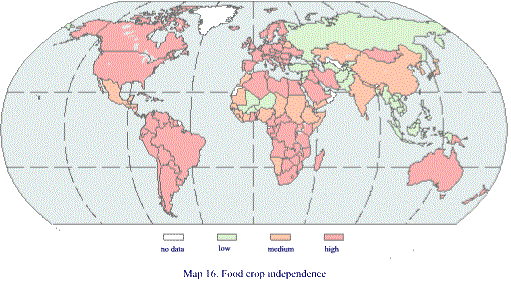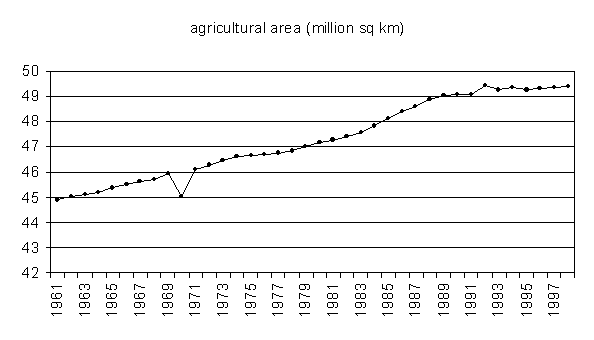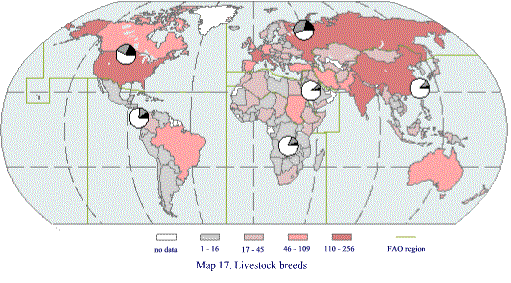TRENDS IN ECOSYSTEM DIVERSITY
Biodiversity of Agricultural Ecosystems
What is agricultural biodiversity?
Agricultural biodiversity is the diversity at all levels of the biological hierarchy, from genes to ecosystems, that is involved in agriculture and food production.
The diverse range of organisms making up agricultural biodiversity can be divided into three major groups, based on the way they contribute to or affect agricultural production (Table 1.13).
Table 1.13
Agricultural biodiversity: functional groups | |
| Producers |
the domestic, cultivated, farmed and semi-wild species (mainly flowering plants, fishes, birds and mammals) whose production provides human food, together with the varieties and wild relatives that expand the genetic resource base for future breeding improvements. |
| Support services |
the wild and semi-managed species (mainly micro-organisms and invertebrates) that provide services supporting agricultural production, notably the soil biota, pollinators and the predators that affect pest species. |
| Pests, pathogens, predators |
the wild species (mainly micro-organisms and invertebrates) that decrease agricultural production by causing disease or damage to producers. |
The fundamental and distinct property of agricultural biodiversity is that it is largely created, maintained and managed by humans, originally by subsistence farming communities, but more recently also by biotechnologists, in part using material in
ex situ genetic resource collections. In this regard, agricultural biodiversity stands in total contrast to wild biodiversity, which is most valued
in situ and as a product of natural evolution.
Although agricultural ecosystems provide some of the environmental services provided by wild ecosystems, in that they can, for example, protect soil structure and affect air and water quality, the magnitude of such benefits from converted ecosystems will generally not exceed those provided by natural ecosystems. The cultural and spiritual benefits that are often associated with traditional agricultural landscapes provide an important exception to this generalisation.
Wild species and their products used for food are not usually regarded as part of agricultural biodiversity unless there is some degree of resource management involved, so, for example, species involved in coastal or inland fish farming come within the scope of agricultural biodiversity, but (for most purposes) high seas fishery species do not.
Where does agricultural biodiversity occur?
The components of agricultural biodiversity variously occur in protected areas, seed banks, laboratories, and the stores of industrial seed producers, but their primary habitat is land supporting agricultural production. Although most crop production is rainfed and based in the cool to warm humid regions of the world, production is extended into drylands by irrigation. Domestic livestock can thrive under a variety of climatic conditions. The ability of sheep, goats and camels to exist on sparse vegetation with little water allows humans to occupy marginal drylands, and the semi-domestic reindeer ranges into arctic regions.
At the close of the Pleistocene, some 11,500 years before present, domestication of plants and animals had just begun and the area of agricultural land would have been imperceptibly small. The history of agriculture is a history of experimentation with plant and animal genetic resources by human communities, and the dispersion of these resources by trade and the migration of peoples. Map 15 shows possible centres of origin of major crop plants. Map 16 presents the high dependence that most countries have on food crops that originated in distant centres of origin.

Agricultural land now forms a significant proportion, some 38%, of the world's total land area. Table 1.14 shows global level estimates of the recent area of land use types relating to agriculture, based on aggregated national data collated by the FAO. In this classification, permanent pastures, which include wild and cultivated forage crops, grassland and rangelands, make up the largest area of agricultural land. Land regularly cultivated for mainly annual crops, ranging from kitchen gardens to the cereal plains of industrial farming, i.e. arable lands in the usual sense, form 11% of the total.
Clearly, at global level, the habitat of agricultural biodiversity has increased enormously during the past ten millennia. Although some care is needed in interpreting these data, a graph of estimates of agricultural land area shows the rate of increase from the 1960s to the present (apart from an anomalous datum for 1970) (Figure 1.1). An increase in area attributed to one classification unit must entail a decrease in some other land cover type; in this case, the increase in agricultural land is accompanied by a decrease in forest and woodland area, and a decrease in the category `all other land'.
Table 1.14
Agricultural land in relation to total world land area | |
| |
Area in 1998
(million km2) |
% world land area |
| World land, excluding inland waters |
130.5 |
100 |
| Agricultural land: |
49.4 |
38 |
| Arable land (mainly annual crops) |
13.8 |
11 |
| Permanent crops (e.g. fruit and nut trees) |
1.3 |
1 |
| Permanent pasture (incl. rangeland) |
34.3 |
26 |
Source: estimates rounded from FAO land-cover data for 1998, available at
http://apps.fao.org

Figure 1.1
World area of land classed as `agricultural' 1961-1998

Source: FAO (FAOSTAT Agricultural database on
www.fao.org)
Although the area of land used for agricultural purposes has increased during the latter half of the 20
th century, by some measures the quality of that land has declined. According to the FAO's Global Assessment of the Status of Human Induced Soil Degradation (GLASOD), about 35 million km
2 of the world total land surface (26%) has suffered degradation severe enough to destroy its productive capacity. The majority of this degradation will have affected agricultural land, and on more than 12 million km
2 (9% of world land area) it is attributed to agricultural activities. At local level, however, it appears that previous global studies may have exaggerated the severity of degradation or its impact on productivity. It is expected that the rate of forest clearance for agriculture is likely to slow, but steep slopes and wetlands will increasingly undergo conversion to agricultural land, and this will have undesirable impacts on non-agricultural biodiversity.
The status of living agricultural resources
A very large variety of species are used for human food, some harvested directly from the wild, some subject to modest management intervention (for example replanting, predator protection, restocking), and some produced by intensive industrial-scale methods. There are few quantitative data available relating to the status of wild and low-management food resources, but indications are that they have in very many instances been adversely affected by land conversions, or by excess harvesting (many marine and some inland fisheries).
More information is available on the status of agricultural plant genetic resources, where a large number of varieties and landraces have been lost, although it remains difficult to derive a quantified view of the situation globally because the basic resource documentation is incomplete. There is, however, abundant evidence at national level of the enormous scale of genetic erosion in crop plants (Table 1.15).
There are far fewer livestock breeds, and documentation is more complete, so that among domestic mammals and birds it is possible to give numerical minimum estimates of the large number of varieties regarded as extinct or at risk of extinction (Table 1.16 and Map 17).

Although some locally distributed plant genetic resources, particularly among the wild relatives of crop plants, have been lost as a result of land conversion, many resources once actively used have been lost because other varieties have proved to have superior production qualities. The former is the second most frequently cited cause of genetic erosion in country reports collated by the FAO, while the latter is the predominant cause. Replacement by modern, genetically more uniform breeds specialised for intensive systems is the main cause of loss of livestock breeds.
The full significance of the loss of varieties of crop plants and livestock, and their wild relatives, is difficult to evaluate. The loss of a cultivated plant variety might entail little or no loss of individual genes not present in other varieties although a particular pattern of gene regulation or interaction may be lost. It can be assumed, on the basis of much evidence, often anecdotal, that many local varieties possessed features of adaptive value in a local context, and their continued existence presents the opportunity for using the genes responsible in breeding improvements more generally. The precautionary principle implies that such diversity should be conserved.
Table 1.15
Loss of crop plant genetic resources: examples at country level | |
| Country |
resource |
varieties lost |
notes |
| China |
wheat varieties |
90% loss |
of 10,000 varieties used in 1949 about 1000 (10%) remained in 1970s |
| Korea (S) |
garden landraces |
74% loss |
of 14 crops in home gardens, 26% of landraces present in 1985 remained in 1993 |
| Mexico |
maize varieties |
80% loss |
only 20% of maize varieties planted in 1930s remain; maize being replaced by more profitable crops |
| USA |
Varieties of apple, cabbage, field maize, pea, tomato |
80-95% loss |
percent loss comparing varieties grown 1804-1904 and present |
Source: FAO. 1998. The state of the world's plant genetic resources for food and agriculture. FAO, Rome.
Table 1.16
The global status of major plant and animal genetic resources for food | |
No. species known in total
(approx) |
No. species domesticated
(approx) |
Most important to global-level food supply |
No. domestic breeds and varieties |
No. domestic breeds and varieties at risk |
No. domestic breeds and varieties extinct |
| Plants |
| 270,000 |
200 |
Bananas/plantains, beans, cassava, maize, millet, potatoes, rice, sorghum, soybean, sugar cane, sweet potatoes, wheat |
Many thousands |
Thousands |
Not known |
| Mammals |
| 5,000 |
20 |
cattle, pigs |
>3000 |
>500 |
238 |
| Birds |
| 10,000 |
10 |
chickens |
>860 |
>370 |
25 |
Source: data on livestock breed status from Scherf , B D. 1995. World Watch List for domestic animal diversity. 2
nd edition. FAO, Rome.
Soil degradation can include impairment of ecological services mediated by soil organisms, such as bacteria, fungi and small invertebrates, but there is little detailed information available on the overall status of soil biodiversity, or the resilience of these species following environmental change.
There is, however, an increasing amount of information relating to declines in abundance of some pollinators.
6 It is estimated that two-thirds of the world's species of agricultural crops require animals for pollination. Species responsible for this service include birds, wasps, beetles, butterflies, bats, moths, giraffes, opossums and flies, but by far the greatest part is provided by bees. Although most estimates of the economic value of crop pollinators give credit to the honeybee (
Apis mellifera), many other species of bee are involved.
However the numbers of native bees are dwindling. The losses are due mostly to the use of agrochemicals and monocultures, and to deforestation. The chemicals kill bees and, with the removal of wild vegetation and crop specialisation, the bees find neither places to nest nor alternative flowers while they wait for the crop to bloom. In addition, honeybees in many parts of the world have contracted a serious disease and the numbers of honeybee colonies have decreased dramatically.
We have little or no information on most of the world's crops that will permit us to say whether they receive adequate visits of pollinators to effect maximum yields, yet research on numerous crops has demonstrated clearly that pollination can be a limiting factor to yields. The rapid development of transgenic crops raises additional causes for concern, as the employment of a herbicide or pesticide coupled with a variety of crop resistant to this could eradicate all alternative forage for pollinators, leading to devastation in their numbers.